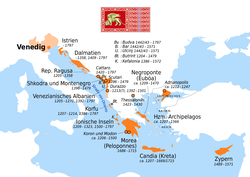
Back Republiek Venesië Afrikaans Republik Venedig ALS Republica de Venecia AN جمهورية البندقية Arabic جمهورية ڤينيسيا ARZ República de Venecia AST Venesiya Respublikası Azerbaijani ونیز جومهوریتی AZB Венецыянская рэспубліка Byelorussian Вэнэцыянская рэспубліка BE-X-OLD
Most Serene Republic of Venice | |||||||||
|---|---|---|---|---|---|---|---|---|---|
| 697–1797 | |||||||||
Coat of arms
(16–18th cent.) | |||||||||
| Motto: Viva San Marco | |||||||||
| Greater coat of arms (1706) | |||||||||
 Map of the Venetian overseas domains (Stato da Màr) | |||||||||
| Capital | |||||||||
| Official languages | |||||||||
| Minority languages | |||||||||
| Religion | Roman Catholicism (state) | ||||||||
| Demonym(s) | Venetian | ||||||||
| Government | Unitary mixed parliamentary classical republic under a mercantile oligarchy | ||||||||
| Doge | |||||||||
• 697–717 (first) | Paolo Lucio Anafestoa | ||||||||
• 1789–1797 (last) | Ludovico Manin | ||||||||
| Legislature | Great Council (since 1172) | ||||||||
• Upper chamber | Senate | ||||||||
• Lower chamber | Council of Ten (since 1310) | ||||||||
| Historical era | |||||||||
• Establishment under first dogea as province of the Byzantine Empire | 697 | ||||||||
• Pactum Lotharii (recognition of de facto independence, "province" dropped from name) | 840 | ||||||||
• Golden Bull of Alexios I | 1082 | ||||||||
| 1177 | |||||||||
| 1204 | |||||||||
| 1412 | |||||||||
| 1571 | |||||||||
| 1718 | |||||||||
| 1797 | |||||||||
| Currency | Venetian ducat Venetian lira | ||||||||
| |||||||||
a. ^ Paolo Lucio Anafesto is traditionally the first Doge of Venice, but John Julius Norwich suggests that this may be a mistake for Paul, Exarch of Ravenna, and that the traditional second doge Marcello Tegalliano may have been the similarly named magister militum to Paul. Their existence as doges is uncorroborated by any source before the 11th century, but as Norwich suggests, is probably not entirely legendary. Traditionally, the establishment of the Republic is, thus, dated to 697 AD, not to the installation of the first contemporaneously recorded doge, Orso Ipato, in 726. | |||||||||
The Republic of Venice,[a] officially the Most Serene Republic of Venice and traditionally known as La Serenìssima,[b] was a sovereign state and maritime republic with its capital in Venice. Founded, according to tradition, in 697 by Paolo Lucio Anafesto, over the course of its 1,100 years of history it established itself as one of the major European commercial and naval powers. Initially extended in the Dogado area (a territory currently comparable to the Metropolitan City of Venice), during its history it annexed a large part of Northeast Italy, Istria, Dalmatia, the coasts of present-day Montenegro and Albania as well as numerous islands in the Adriatic and eastern Ionian seas. At the height of its expansion, between the 13th and 16th centuries, it also governed the Peloponnese, Crete and Cyprus, most of the Greek islands, as well as several cities and ports in the eastern Mediterranean.
The islands of the Venetian Lagoon in the 7th century, after having experienced a period of substantial increase in population, were organized into Maritime Venice, a Byzantine duchy dependent on the Exarchate of Ravenna. With the fall of the Exarchate and the weakening of Byzantine power, the Duchy of Venice arose, led by a doge and established on the island of Rialto; it prospered from maritime trade with the Byzantine Empire and other eastern states. To safeguard the trade routes, between the 9th and 11th centuries the Duchy waged several wars, which ensured its complete dominion over the Adriatic. Owing to participation in the Crusades, penetration into eastern markets became increasingly stronger and, between the 12th and 13th centuries, Venice managed to extend its power into numerous eastern emporiums and commercial ports. The supremacy over the Mediterranean Sea led the Republic to the clash with Genoa, which lasted until the 14th century, when, after having risked complete collapse during the War of Chioggia (with the Genoese army and fleet in the lagoon for a long period), Venice quickly managed to recover from the territorial losses suffered with the Treaty of Turin of 1381 and begin expansion on the mainland.
Venetian expansion, however, led to the coalition of the Habsburg monarchy, Spain and France in the League of Cambrai, which in 1509 defeated the Republic of Venice in the Battle of Agnadello. While maintaining most of its mainland possessions, Venice was defeated and the attempt to expand the eastern dominions caused a long series of wars against the Ottoman Empire, which ended only in the 18th century with the Treaty of Passarowitz of 1718 and which caused the loss of all possessions in the Aegean. Although still a thriving cultural centre, the Republic of Venice was occupied by Napoleon's French troops and its territories were divided with the Habsburg monarchy following the ratification of the Treaty of Campo Formio.
Throughout its history, the Republic of Venice was characterized by its political order. Inherited from the previous Byzantine administrative structures, its head of state was the doge, a position which became elective from the end of the 9th century. In addition to the doge, the administration of the Republic was directed by various assemblies: the Great Council, with legislative functions, which was supported by the Minor Council, the Council of Forty and the Council of Ten, responsible for judicial matters, and the Senate.
- ^ "VENEZIA E LA LINGUA UFFICIALE DELLO STATO VENETO". VENEZIA E LA LINGUA UFFICIALE DELLO STATO VENETO. Archived from the original on 2 November 2022. Retrieved 2 November 2022.
- ^ Francesca Forzan (29 May 2021). "Venezia 1600: un dialetto e una lingua" (in Italian). Università di Padova. Archived from the original on 26 December 2022. Retrieved 26 December 2022.
Cite error: There are <ref group=lower-alpha> tags or {{efn}} templates on this page, but the references will not show without a {{reflist|group=lower-alpha}} template or {{notelist}} template (see the help page).



